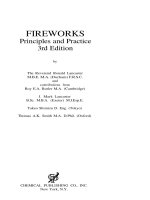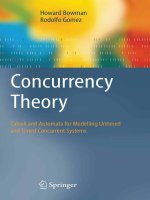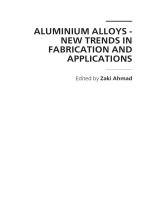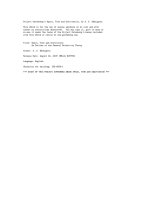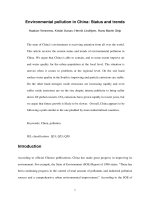SEMICONDUCTORS AND SEMIMETALS pot
Bạn đang xem bản rút gọn của tài liệu. Xem và tải ngay bản đầy đủ của tài liệu tại đây (13.37 MB, 317 trang )
SEMICONDUCTORS
AND
SEMIMETALS
VOLUME
21
Hydrogenated
Amorphous
Sijkon
Device Applications
Part D
Semiconductors and Semimetals
A
Treatise
Edited
by
R.
K.
WILLARDSON
WILLARDSON CONSULTING
SPOKANE, WASHINGTON
ALBERT
C.
BEER
BATTELLE COLUMBUS LABORATORIES
COLUMBUS, OHIO
SEMI
C
0
ND
UC
T
0
R
S
AND
SEMIME'TALS
VOLUME
21
Hydrogenated
Amorphous
Silicon
Device Applications
Part
D
Volume
Editor
JACQUES
I.
PANKOVE
RCAfDAVlD SARNOFF RESEARCH CENTER
PRINCETON. NEW JERSEY
1984
ACADEMIC
PRESS, INC.
Harcourt Brace Jovanovich, Publishers
Orlando San Diego New
York
Austin London Montreal Sydney
Tokyo Toronto
COPYRIGHT
@
1984,
BY
ACADEMIC
PRESS,
INC.
ALL
RIGHTS
RESERVED.
NO
PART OF
THIS
PUBLICATION MAY BE REPRODUCED OR
TRANSMITTED
IN
ANY
FORM OR BY
ANY
MEANS, ELECTRONIC
OR MECHANICAL, INCLUDING PHOTOCOPY, RECORDING, OR
Am
INFORMATION
STORAGE
AND
RETRIEVAL SYSTEM,
WITHOUT
PERMISSION
IN
WRITING FROM THE PUBLISHER.
ACADEMIC
PRESS,
INC.
Orlando, Florida
32887
United Kingdom Edition published
by
ACADEMIC
PRESS,
INC.
(LONDON)
LTD.
24/28
Oval
Road,
London
NWl
IDX
Library
of
Congress Cataloging in Publication Data
(Revised
for
volume
2 18-21
D)
Main entry under title:
Semiconductors and semimetals
Includes bibliographical references and indexes.
Contents: v.
1-2.
Physics
of
111-V
compounds v.
3.
Optical properties
of
Ill-V compounds
pt.
B,
C,
D.
Hydrogenated amorphous silicon.
Collected
works.
I.
Willardson, Robert
K.
11.
Beer,
Albert C.
-v.
21,
1.
Semiconductors-Collected
works. 2.
Semimetab-
QC610.9S47 531.6’22 65-26048
ISBN 0-12-752150-X (21D)
PRINTED INTHE UNITEDSTATES OFAMERICA
86
117
8X
XY
9
8
7
6
5
4
3
Z
Contents
LIST
OF
CONTRIBUTORS
xi
FOREWORD
xiii
PREFACE
xv
Chapter
1
Introduction
Jacques
I
.
Pankove
1
References
6
Chapter
2
Solar Cells
D
.
E
.
Carlson
I
.
Introduction
7
I1
.
MethodsofGrowing AmorphousSilicon for Solar Cells
8
I11
.
Relevant Material Properties
10
IV
.
Solar-Cell Fabrication and Performance
19
V
.
Cost Projections
32
VI
.
Future Directions
33
References
35
Chapter 3
Closed-Form Solution of
I-
Y
Characteristic
for a-Si
:
H
Solar Cells
G
.
A
.
Swartz
List of Symbols
39
I
.
Introduction
40
I1
.
ProposedModel
40
111
.
Interrelation of
q.
FF.
and
JJJ,
49
IV
.
Summary
52
References
53
V
vi
CONTENTS
Chapter
4
Electrophotography
Isamu Shimizu
I
.
Introduction
55
I1
.
Advantages Expected from a-Si
:
H
as
Photoreceptor
of Electrophotography
56
I11
.
Material Design for a-Si
:
H Photoreceptor
58
IV
.
Photoinduced-Discharge (PID) Characteristics
62
V
.
Problems Remaining Today
72
References
72
Chapter
5
Image Pickup Tubes
Sach io Ish ioka
I
.
Introduction
75
I1
.
a-Si: H Image Pickup Tube
76
I11
.
Properties of a-Si
:
H
78
IV
.
Blocking Contact Structure of the Photoconductive Target
80
V
.
Impurity Doping of a-Si
:
H
82
VI
.
Characteristics of a-Si
:
H Image Pickup Tubes
83
VII
.
Applications for a-Si
:
H Target
86
References
87
Chapter
6
The Development
of
the a-Si
:
H
Field-Effect
Transistor and Its Possible Applications
P
.
G
.
LeComber and
W
.
E
.
Spear
I
.
Introduction
I1
.
The Field Effect in Glow-Discharge a-Si
:
H
I11
.
Design and Fabrication
of
the a-Si
:
H
FET
IV
.
Direct-CurrentCharacteristics
V
.
DynamicPerformance
VI
.
Reproducibility and Stability
VII
.
Investigation of the ON-State
VIII
.
Radiation Hardness of a-Si
:
H
FETs
.
.
IX
.
Some Possible Applications of a-Si
:
H FETs
X
.
Limitations of Present a-Si
:
H
FETs
.
.
References
89
90
93
95
98
99
101
105
108
112
113
Chapter
7
a-Si
:
H
FET-Addressed LCD Panel
D
.
G
.
Ast
I
.
Introduction
115
I1
.
Properties
of
Liquid Crystals
115
CONTENTS
vii
I11
.
Principles of Multiplexing
IV
.
Electrical Specifications of Extrinsic Threshold Devices
V
.
Active-Matrix-Addressed Liquid Crystal Displays
Chapter
8
Solid-state Image Sensor
S
.
Kaneko
I
.
Introduction
139
I1
.
Application to a Long Linear Image Sensor
140
I11
.
Application
to
a
Scanning Circuit
152
154
V
.
Future Expectations
157
References
157
IV
.
Application
to
an Area Image Sensor
Chapter
9
Charge-Coupled
Devices
Masakiyo Matsumura
I
.
Introduction
161
I1
.
Theoretical Results on Charge Transfer
162
111
.
CCD
Structure
for High-Frequency Operation
167
IV
.
Experimental Results
168
References
172
V
.
Conclusion
171
Chapter
10
Optical Recording
M
.
A
.
Bosch
I
.
Summary
173
I1
.
Introduction and
Scope
174
111
.
Optical Recording in a-Si
175
IV
.
Optical Recording in a-Si
:
H
183
V
.
Electrically Amplified Writing
199
VI
.
Outlook
205
References
206
Chapter
11
Ambient Sensors
A
.
D’Amico and
G
.
Fortunato
1.Introduction.
209
I1
.
Adsorbate Effects
211
viii
C
0
N
T
E
N
T
S
I11
.
Thermistors
213
IV
.
MIS
Diodes for Hydrogen Detection
216
V
.
FET Structures
for
Ion and Gas Sensors
228
VI
.
Conclusions
234
References
235
Chapter
I
2
Amorphous Light-Emitting Devices
Hiroshi Kukimoto
I
.
Introduction
239
241
111
.
Electroluminescence of a.Si.C,-
.
:
H
244
IV
.
Future Developments
245
References
247
I1
.
Preparation and Properties of a.Si.C,
.
H
Chapter
13
Fast Detectors and Modulators
Robert J
.
Phelan. Jr
.
I
.
Introduction
249
I1
.
Devices
251
111
.
Conclusions
258
References
259
Chapter
14
Hybrid Structures
Jacques
I
.
Pankove
1
.
Introduction
261
I1
.
Passivation of Crystalline Silicon
261
111
.
Heterojunctions
270
IV
.
Optical Waveguides
272
References
272
Chapter
15
Electronic Switching
in
Amorphous
Silicon Junction Devices
P
.
G
.
LeComber.
A
.
E.
Owen.
W
.
E
.
Spear.
J
.
Hajto. and
W
.
K
.
Choi
I
.
Introduction
275
I1
.
Previous Work on Electrical Switching in Amorphous Silicon
277
111
.
Device Structure and Fabrication
279
CONTENTS
ix
IV
.
Static Current-Voltage Characteristics of Virgin Devices
V
.
Forming: Static Characteristics
VI
.
Forming: Dynamic Characteristics
VII
.
Dynamic Switching
of
Formed Devices
VIII
.
Discussion of Possible Switching Mechanisms
279
281
282
284
286
References
288
INDEX
CONTENTSOFPREVIOUSVOLUMES
291
295
This Page Intentionally Left Blank
List
of
Contributors
Numbers in parentheses indicate the pages on which thi: authors’ contributions begin.
D.
G.
Asr,
Department
of
Materials Scietice and Engineering, Cornell
M.
A.
BOSCH,
AT&T Bell Laboratories, Holmdel, New Jersey 07733
(173)
D.
E.
CARLSON,*
RCA/David Sarnof Restparch Center, Princeton, New
Jersey
08540
(7)
W.
K.
CHOI,
Department
of
Electrical Engineering, University
of
Edin-
burgh, Edinburgh EH9 3JL, Scotland
(275)
A.
D’AMICO,
Istituto di Elettronica dell0 Star
o
Solido, Consiglio Nazionale
delle Ricerche,
00156
Rome, Italy
(209)
G.
FORTUNATO,
Istituto di Elettronica delh Stato Solido, Consiglio Na-
zionale delle Ricerche,
00156
Rome, Italy
(209)
J.
HAJTO,
Department
of
Electrical Engineering, University
of
Edinburgh,
Edinburgh EH9 3JL, Scotland
(275)
SACHIO
ISHIOKA,
Central Research Laborat wy, Hitachi, Ltd., Kokubunji,
Tokyo
185,
Japan
(75)
S
.
KA
N
E
KO,
Microelectronic Research Lat lorat ories, NEC Corporation,
Kawasaki 213, Japan
(1 39)
HIROSHI
KUKIMOTO,
Imaging Science and Engineering Laboratory, Tokyo
Institute
of
Technology, Nagatsuta, Yokohama 227, Japan
(239)
P.
G.
LECOMBER,
Carnegie Laboratory
of
P)hysics, The University
of
Dun-
dee, Dundee DDI 4HN, Scotland
(89, 275)
MASAKIYO
MArSuMuRA,
Department
of
Physical Electronics, Tokyo Insti-
tute
of
Technology, 0-Oka.yama, Tokyo 152, Japan
(16
1)
A.
E.
OWEN,
Department
of
Electrical Enpineering, University
of
Edin-
burgh, Edinburgh EH9 3JL, Scotland
(275)
JACQUES
I.
PANKOVE,
RCA/David Sarnoj- Research Center, Princeton,
New Jersey
08540
(
1,
26
1
)
University, Ithaca, New York
14853
(1
15)
*
Present address: Thin Film Division, Solarex Cxporation, Newtown, Pennsylvania
18940.
xi
xii
LIST
OF
CONTRIBUTORS
ROBERT
J.
PHELAN,
JR.,
National Bureau
of
Standards, Boulder, Colorado
ISAMU
SHIMIZU,
Imaging Science and Engineering Laboratory, Tokyo
W.
E.
SPEAR,
Carnegie Laboratory
of
Physics, The University
of
Dundee,
G.
A.
SWARTZ,
RCA/David SarnoflResearch Center, Princeton, New Jersey
80303
(249)
Institute
of
Technology, Nagatsuta, Yokohama
227,
Japan
(55)
Dundee DD1 4HN, Scotland
(89,275)
08540
(39)
Foreword
This book represents a departure from the usual format of “Semiconduc-
tors and Semimetals” because it is a part of a four-volume miniseries
devoted entirely to hydrogenated amorphous silicon (a-Si
:
H). In addition,
this group of books
-
Parts
A
-
D of Volume
2
1
-has been organized by a
guest editor, Dr.
J.
I.
Pankove, an internatiorially recognized authority on
this subject. He has assembled most of the who’s who in this field as authors
of the many chapters. It is especially fortunate that Dr. Pankove, who has
made important original contributions to our understanding of a-Si
:
H,
has
been able to devote the time and effort necessary to produce this valuable
addition to our series. In the past decade, a-Si
:
H
has developed into an
important family of semiconductors. In hydrogenated amorphous silicon
alloys with germanium, the energy gap decreases with increasing germa-
nium content, while in alloys with increasing carbon content the energy gap
increases. Although many applications are still under development, efficient
solar cells for calculators have been commercial for some time.
In Volume
21,
Part A, the preparation of a-Si:H
by
rf and dc glow
discharges, sputtering, ion-cluster beam, CVD, and homo-CVD techniques
is discussed along with the characteristics of the silane plasma and the
resultant atomic and electronic structure and characteristics.
The optical properties of this new family of semiconductors are the
subject
of
Volume
2
1,
Part
B.
Phenomena discussed include the absorption
edge, defect states, vibrational spectra, electroreflectance and electroabsorp-
tion, Raman scattering, luminescence, photoconductivity, photoemission,
relaxation processes, and metastable effects.
Volume
2
1,
Part
C,
is concerned with electronic and transport properties,
including investigative techniques employing field effect, capacitance and
deep level transient spectroscopy, nuclear and optically detected magnetic
resonance, and electron spin resonance. Parameters and phenomena con-
sidered include electron densities, carrier mobilities and diffusion lengths,
densities of states, surface effects, and the Staebler- Wronski effect.
The last volume of this miniseries,
2
1,
Part
13,
covers device applications,
including solar cells, electrophotography, im.sge pickup tubes, field effect
transistors
(FETs)
and FET-addressed liquid crystal display panels, solid
state image sensors, charge-coupled devices, optical recording, visible light
xiii
xiv
FOREWORD
emitting diodes, fast modulators and detectors, hybrid structures, and
memory switching.
R.
K.
WILLARDSON
ALBERT
C.
BEER
Preface
Hydrogenated amorphous silicon, a new form of a common element, is a
semiconductor that has come of age. Its scientific attractions include a
continuously adjustable band gap, a usable camer lifetime and diffusion
length, efficient optical transitions, and the capability of employing either
n-
or p-type dopants.
Furthermore, it can be fabricated very easily as a thin film by a technology
that not only inherently escapes the expenst: of crystal perfection but also
requires significantly smaller amounts of raw materials.
The discovery of a new material endowed with wondrous possibilities for
very economical practical applications naturally attracts many researchers
who invariably provide new insights and further vision. Their meditation
and experimentation build up rapidly and lead to a prolific information flow
in journals and conference proceedings.
The initial cross-fertilization generates an overload of data; books are
written that attempt to digest specialized aspects of the field with state-of-
the-art knowledge that often becomes obsolete by the time the books are
published a year or two later.
We have attempted to provide this book with a lasting quality by empha-
sizing tutorial aspects. The newcomer
:o
this field will not only learn about
the properties of hydrogenated amorphous silicon but also how and why
they are measured, and the variety of practical applications possible with
this method.
In most chapters, a brief historical review depicts the evolution of relevant
concepts. The state of the art emerges, and a bridge to future developments
guides the reader toward what still needs to be done. The abundant refer-
ences should be a valuable resource for the future specialist.
We hope that this tutorial approach by seaslmed experts satisfies the needs
of at least one generation of new researchers.
xv
This Page Intentionally Left Blank
SEMICONDUCTORS AND SEMIMETALS.
VOL.
21,
PART
D
CHAPTER
1
Introduction
Jacques
I.
Pankove
RCA~DAVID
SARNOFF
RESEARCH
CENTER
PRINCETON, NEW JERSEY
This first chapter summarizes the content:; of this volume. Where rele-
vant, we have added several other new device applications of a-Si
:
H that
have come to our attention since the authors have written their contribu-
tions. The authors of this volume have belzn chosen for their eminent
contributions in the various approaches that 'broaden the usefulness of this
material.
In Chapter
2,
Carlson reviews and compares various a-Si
:
H deposition
methods that have been used to make solar cells. He points out the impor-
tance of various material properties to the efficient performance of solar
cells, for example, the absorption edge that depends on hydrogen concen-
tration. Also, alloying Si with other elements such as carbon and germanium
affects the absorption edge, thus allowing a stacking of cells with successively
narrower energy band gaps to utilize more efficiently the solar spectrum.
Carlson discusses the relationship between the collection length and the
diffusion length. He stresses the detrimental influence of gap states, those
due to dangling bonds and those introduced by various impurities that are
often present in a deposition system. There is also concern for defects that
may enhance light-induced effects and concern over the doping efficiency
that determines the maximum obtainable photovoltage. Several cell struc-
tures are described and the performance
of
the better cells is reported.
Light-induced degradation is negligible in thin cells because the resulting
large electric field separates the photogenerated electron
-
hole pairs before
they can recombine. Carlson describes techniques for making solar cells on a
commercial scale. He considers the economics of solar-cell fabrication for
power generation (e.g., most of the cost is in the supporting structure) and
projects that a 20% conversion efficiency using stacked cells could be
achieved by the end of this decade.
In Chapter
3,
Swartz presents a model for tliep-
i-n
solar cell consisting
of two transitions (like two portions of a
p-n
junction) separated by a
photoconductive
i
layer. Various physical properties can
be
incorporated
1
Copyright
0
1984
by
Academic
Prrss
Inc.
AU
rights
of mroduction
in
any
form
mrved.
ISBN
0-12-752150-X
2
JACQUES
I.
PANKOVE
into the lumped-circuit constants to generate the corresponding
I-
V
char-
acteristics. Conversely, the observed characteristic can be used to evaluate
the appropriate physical property. Thus, the light-induced degradation can
be attributed to a reduced bamer at the
p+-i
layer interface and to a
reduction of the
pct
product.
In Chapter
4,
Shimizu describes the use of a-Si
:
H as a photoreceptor for
transferring an image by electrophotography. Hydrogenated amorphous
silicon is endowed with a very low electrical conductivity, a long charge
decay time, an excellent spectral sensitivity in the visible, and a good
chemical inertness. The retention of a surface charge is helped by blocking
layers at both surfaces of the a-Si
:
H films. An excellent image reproducibil-
ity with high resolution and good contrast was demonstrated in a commer-
cial machine whose Se-coated drum was replaced by one coated with
a-Si
:
H.
Hydrogenated amorphous silicon photoreceptors for electrophotography
have been coated with a thin layer
(<
100
nm) of a-SiO,
:
H by Nakayama
ef
al.
(
1983).
This overcoat improves the stability of the photoreceptor against
temperature and humidity cycling. A photoreceptor consisting of a
1-pm-
thick layer of a-SiGe
:
H sandwiched between two a-Si
:
H layers was devel-
oped by Nishikawa
et
al.
(
1983)
to match a GaAlAs LED. This device, which
has a sensitivity of
0.5
pJ
cm-, at
600
nm, was passivated with a thin layer
of a-Sic.
In Chapter
5,
Ishioka describes the use of a-Si
:
H in imaging tubes. The
a-Si: H is a photoconductor having the vacuum side charged to cathode
potential. Light causes charge leakage during a frame time; the signal is the
electron-beam current needed to recharge the surface. Blocking contacts are
used to reduce the leakage current. Hydrogenated amorphous silicon has a
broad spectral response that is especially sensitive in the visible range. The
signal current is proportional to the light intensity at all wavelengths, which
simplifies color balancing. The spatial resolution is comparable to that of
commercial vidicons and exhibits neither blooming nor image burning
under strong illumination. When used to intensify x-ray images, the a-Si
:
H
imaging tube has a better resolution than conventional image intensifiers. A
single-tube color camera has been demonstrated using striped color filters
on the face plate.
Although the development of field-effect transistors (FETs) has already
reached a high level of perfection in crystalline silicon (c-Si), a-Si
:
H offers
the advantage that very large arrays of a-Si
:
H FETs are feasible. Hence,
even
if
their performance level is much lower than that of c-Si FETs, there
are still many applications where their characteristics may be adequate.
In
Chapter
6,
LeComber and Spear review the design, fabrication, and per-
formance of a-Si
:
H FETs. They point out the need for good ohmic connec-
1.
INTRODUCTION
3
tions to source and drain and the problem of achieving
a
good dielectric
under the gate. Sheet conductance of several lo-* mhon and switching
times on the order of a microsecond have been obtained. These devices
appear very resistant to gamma radiation. Among applications briefly
discussed are inverter logic and addressable image sensors. The figure of
merit given by the gain
-
bandwidth product is
5
MHz, a limitation that still
allows many practical uses.
In Chapter
7,
Ast describes the application of a-Si
:
H FETs to a liquid
crystal display (LCD). There is a brief introdusstory review of the principles
involved in changing the orientation of light-polarizing liquid crystals lead-
ing to the possibility for high-contrast imaging using either transmitted or
scattered light. Ast considers the problem of addressing the numerous
elements of an LCD, especially when one needs to avoid a dc bias that might
degrade the liquid crystals by electrolytic acrion. Hence the driving bias
must be periodically reversed. Thus, a symmetrical back-to-back pair of
Schottky diodes could be used to switch liquid crystals allowing several
hundred lines of 1-mm-square pixels to
be
addressed.
If
a high-mobility
semiconductor were used, electrical considerations would require that the
drivers be made at the limits of lithographic resolution. In contrast, the
low-mobility a-Si
:
H is ideally suited for makmg large FETs having a high
OFF-resistance. Furthermore, a-Si
:
H has the advantage of low-temperature
processing
so
that it can be deposited onto inexpensive soda-lime
glass
that
serves as a transparent substrate. An experimental structure is described that
uses a square FET in which the gate surrounds
a
square drain electrode. This
drain serves as a large reflecting electrode for the liquid crystal. The source
electrode that surrounds the gate is an extension of the gate. Hence, there is
no need to etch the a-Si
:
H between source and drain. The early model
consisting of a
26
X
26
array has been operated for more than one year
without degradation.
In Chapter
8,
Kaneko reviews various image sensors suitable for facsimile
transmission or for optical character recognition. He then describes a new
image sensor consisting of a long array of a-Si
:
H photocells that sense the
light reflected along a line illuminated by
it
linear array of LEDs. An
integrated circuit scans the information stored in the photosensors while the
array scans a page one line at a time. Hydrogenated amorphous silicon is
more suitable as a photoconductor for this application than other materials
because of its flatter response in the visible spectrum and because the
fabrication of a long array is readily feasible. Various structures have been
explored. One that is particularly successful in reducing the dark current
employs blocking layers of Si3N, and ptype a-Si
:
W.
Several methods of
switching from element to element are considered, such as sequential
switching with
FETs
of various types and even using charge-coupled devices
4
JACQUES
I.
PANKOVE
(CCD). It is expected that a superposition of the a-Si
:
H sensor and a CCD
should produce a performance comparable to that of a vidicon. With the
addition of a laminated color filter comprising lines of red-, green-, and
blue-pass filters, a color image sensor was demonstrated.
Another potential image sensor is the CCD discussed in Chapter
9
by
Matsumura. The major problem in using a-Si
:
H for CCD applications is
the high density of traps or localized states in the band gap.
A
theoretical
analysis assuming an exponential distribution
of
gap states permits us to
predict the transfer characteristics (residual electron density as a function of
time). With state-of-the-art material it should be possible to make usable
image sensors. Early experimental results with novel test structures have
yielded transfer inefficiencies of less than
1
%
at clock frequencies between
1
and
200
kHz.
In Chapter 10, Bosch reviews optical recording methods, especially those
involving a-Si
:
H.
There is the possibility of generating a microstructure that
has a high absorption coefficient (low reflectance) but becomes highly
reflective upon melting by a laser beam, the surface tension helping the
formation of a smooth imprint.
A
localized amorphous-to-crystalline phase
change also provides absorption and reflectance contrast. The most useful
result is derived from the thermal dehydrogenation of a-Si
:
H. Dehydrogen-
ation provides a decrease in energy gap and hydrogen evolution. The latter
can form a microscopic blister or a crater that can be easily read optically
against a smooth background. Bosch describes a system that greatly reduces
the laser power required to record data. In this approach the a-Si
:
H
is used
as a photoconductor supporting an externally applied voltage. The writing
energy comes from the electrical power dissipated
as
heat when the photo-
conductor is triggered into conduction by the laser pulse. This heat can
blister or crater either the photoconductor or an outer layer of a more
thermally sensitive material. Thus, with an applied voltage, 1.8-pm dots
were recorded with
0.1
mW of laser power (two orders of magnitude lower
than without applied voltage). The presence of hydrogen that passivates the
dangling bonds renders the material corrosion resistant, a quality that is
valued for archival information storage.
In Chapter
1
1, D’Amico and Fortunato report on the use of a-Si
:
H for
measuring the hydrogen concentration in the ambient and also for measur-
ing the temperature of the ambient. In the latter application, the a-Si
:
H is
used as a thermistor. Hydrogen detection utilizes a field-effect transistor in
the form of a MISFET in which a palladium gate catalyzes the
H2
dissocia-
tion and allows atomic hydrogen to modulate the conductivity of the
a-Si
:
H. They also describe
MIS
sensors in which the hydrogen concentra-
tion is obtained from the
C-
V
characteristics. For practical applications,
there is concern over possible long-term changes in barrier height and a need
1.
INTRODUCTION
5
for faster response time and for complete reversibility of characteristics
under reset treatment such as
O2
exposure.
In contrast to all the previously described devices, which are based on the
light-absorbing properties of a-Si
:
H, those examined by Kukimoto in
Chapter
12
are of the light-emitting variety. Although there are applications
for which infrared emission is useful, the most interesting applications for a
light emitter of large area- the distinctive advantage of amorphous semi-
conductors
-
would be for visible displays. Wide-band-gap emitters that are
currently explored are a-Si,CI-,: H and a-Si
:
H made by homoCVD. Ku-
kimoto also mentions the potential advantage of quantum well structures if
impact excitation were a suitable means for exciting electroluminescence
(as
it is in phosphors). However, our own feeling is that impact excitation may
create dangling bonds that would reduce the luminescence efficiency. This
fear is based on our observation that a-Si
:
H never exhibited cathodolumi-
nescence and on our observation of electron-beam-induced defects (see
Volume
2
1
B,
Chapter
1
1).
In Chapter
13
Phelan shows that a-Si
:
H can be used for fast detectors that
take advantage of the high absorption coefficient of this material and of the
short transit time of photogenerated camers in very small structures in the
presence of an electric field. Response times in the tens of picoseconds have
been obtained. Another application for a-Si:H is
as
a fast electro-optic
modulator. There, the electric field changes the refractive index and shifts
the absorption edge (Franz
-
Keldysh effect). The change in refractive index
in the film causes a large spectral shift of the interference pattern. This
change results in a large and rapid modulation of a transmitted monochro-
matic light.
In Chapter
14
Pankove describes several
uses
for a-Si
:
H deposited on
crystalline Si. The most studied of these aplplications is as a passivating
encapsulant that takes advantage of the abundant hydrogen to tie the
dangling bonds at the surface of c-Si and provides a reservoir of hydrogen
that ensures the stability of the interface. Another potential application is as
a heterojunction to make efficient emitters in bipolar c-Si transistors.
Although several attempts have been made at realizing this structure, no
beneficial result has been demonstrated thus far. Still another possible
hybrid combination of amorphous and crystalline materials is the use of
a-Si
:
H as a waveguide to transfer optical signals over a crystalline integrated
circuit without cross talk between optical and electronic interconnections.
This application, which capitalizes on the high refractive index of a-Si
:
H,
also has not been demonstrated.
In Chapter
15,
LeComber
et
al.
describe an intriguing switching phenom-
enon that may have extensive practical applications. The device is a diode
that can be switched to the conducting state by biasing beyond a threshold
6
JACQUES
I.
PANKOVE
with one polarity and switched back to the resistive state by exceeding a
threshold with opposite polarity. The switching is fast
(-
10
nsec), weakly
dependent on temperature, and independent of illumination. The diode
remains indefinitely in the
ON
or
OFF
state until the appropriate threshold
is exceeded.
REFERENCES
Nakayama,
Y.,
Wakita,
K.,
Nakano,
M.,
and Kawamura,
T.
(1983).
J.
Non-Cryst.
Solids
Nishikawa,
S.,
Hakinuma,
H.,
Watanabe,
T.,
and Kaminishi,
K.
(1983).
J.
Non-Crysf.
Solids
59/60,
1231.
59/60,
1235.
SEMICONDUCTORS AND SEMIMETALS, VOL.
21,
PART D
CHAPTER
2
Solar
Cells
D. E.
Carlsont
RCAfDAVID SARNOFF RESEARCH CENTER
PRINCETON, NEW JERSEY
I.
INTRODUCTION
I
CELLS
8
111.
RELEVANT
MATERIAL
PROPERTIES
10
10
1.
Optical Absorption
2.
Transport
11
3.
Density
of
Gap States
13
4.
Impurities.
13
5.
Microstructure
14
6.
Metastable States.
16
Iv.
SOLAR-CELLFABR~CAT~ONAND~RFOR~~ANCE
19
8.
Structures.
19
10.
Modeling
of
Solar-Cell Operation
23
21
12.
Processing
of
a-Si
:
H
Panels
30
V.
COST
PROJECTIONS.
32
VI.
FUTURE
DIRECTIONS
33
REFERENCES
35
11.
METHODS
OF
GROWING
AMORPHOUS
SILICON FOR SOLAR
I.
Doping Eficiency
17
9.
Solar-Cell Perjormance
21
I
1,
Stability
of
a-Si
:
H
Solar Cells
I. Introduction
The photovoltaic effect was first observed in amorphous silicon in 1974 at
RCA Laboratories (Carlson, 1977a). The amorphous silicon films were
grown by the dc glow-discharge decomposition
of
silane (SiH,). Both
Schottky-barrier and
p-
i-n
devices were hbricated that year, but the
conversion efficiencies were limited to less than
1%
mainly because
of
poor
contacts. By 1976 the efficiency
of
the
p-
i-
n
structure had been improved
to 2.4% (Carlson and Wronski, 1976), and in 1977 an efficiency
of
5.5%
was
obtained in a small (2-mm2) Schottky-bamer device (Carlson, 1977b). At
about this time, it was becoming clear that hydrogen was playing an
important role in assuring the good semiconducting properties
of
amor-
t
Present
address:
Thin
Film
Division,
Solarex
Corporation, Newtown, Pennsylvania.
7
Copyright
0
1984
by
Academic
Rns,
Inc.
AU
rinbts
of
mroduction
in
any
form
rr~e~ed.
8
D.
E.
CARLSON
phous silicon and that the films were actually silicon
-
hydrogen alloys
(a-Si
:
H) (Triska
et
al.,
1975;
Connell and Pawlik,
1976).
Continued optimization of the deposition conditions led to efficiencies as
high as
6.1%
in
p-i-n
cells
(1.19
cm2) by
1980
(Carlson,
1980a).
An
efficiency of
6.3%
was reported later that year for a small
(4.2-mm2)
metal
-
insulator- semiconductor (MIS) device fabricated from a glow dis-
charge in SiF, and H, (Madan
et
al.,
1980);
the film used in this MIS device
was a silicon
-
hydrogen
-
fluorine alloy (a-Si
:
H
:
F).
In
1981
an efficiency of
7.5%
was obtained for a
p-i-n
structure
(3.3
mm2) in which the
p
layer was a boron-doped silicon-carbon-hydro-
gen alloy (a-Si:C:H) (Tawada
et
al.,
1981).
A
further improvement in
conversion efficiency to
8.5%
was obtained in
1982
with a stacked junction
structure
(9
mm2) that utilized an amorphous silicon-germanium
-
hydro-
gen alloy (a-Si
:
Ge
:
H) in the back junction of three stacked
p-
i-n
junc-
tions (Nakamura
et
al.,
1982).
More recently, an efficiency of
10.1%
has
been achieved in a
p- i-
n
structure
(
1.2
cm2) utilizingptype a-Si
:
C
:
H
as
a
window layer (Catalano
et
al.,
1982).
Commercialization of amorphous silicon solar cells started in
1980
when
Sanyo introduced calculators powered only by small solar-cell panels (total
area
-
5
cm2). Shortly thereafter, Fuji Electric also started producing a-Si
:
H
solar cells for calculators. As of
1983,
a-Si:H photovoltaic devices are
produced for several other applications such as photodetectors, power
supplies for watches, and NiCd battery chargers. Before the end of
1984
one
may see a-Si
:
H solar panels used in larger-scale applications such as imga-
tion and remote electrification.
In this article, we first review the methods of growing amorphous silicon
for solar cells. The next part covers the material properties that are relevant
to the development of efficient, stable a-Si
:
H solar cells. In Part IV, we
discuss the fabrication, performance, and scale-up of a-Si
:
H solar cells, and
in Part V, we consider the economics of these cells for various applications.
We conclude with some projections for the future of a-Si
:
H photovoltaics.
11.
Methods
of
Growing Amorphous Silicon
for
Solar Cells
Several techniques have been used to grow a-Si
:
H films for solar cells. As
shown in Table
I,
the highest-efficiency cells have been made from films
grown in glow discharges in silane (SiH,). Conversion efficiencies greater
than
9%
have been reported for devices made from silane glow discharges
using rf external capacitive coupling (Hamakawa
et
al.,
1983),
rf internal
capacitive coupling (Kuwano
et
al.,
1983),
and the dc proximity mode
(Catalano
et
al.,
1982).
Comparable performance has also been reported for
devices that were apparently made from glow discharges in silicon tetrafluo-
ride (SiF,) and hydrogen (Hack and Shur,
1982).
Glow discharges in disilane

